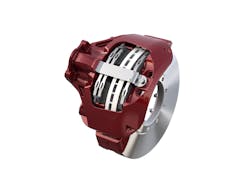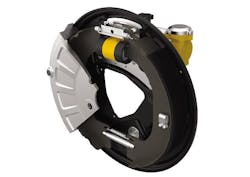Motion Control: Getting to Know Braking Systems and their Applications
At a Glance:
- An introduction to the core principles of braking systems in mechanical design.
- A high-level introduction to the application of braking systems in machinery and equipment, as well as their relevance in automotive and aerospace.
Have you ever stomped on the brake pedal while driving and come inches away from a potential auto accident? If yes, your vehicle’s braking system had to absorb large amounts of kinetic energy to go from 60-0 in those fleeting seconds and dissipate it as heat into the brake discs.
Larger vehicles, such as trucks and buses, require much greater braking power in order to achieve the same rapid deceleration. Now, imagine the challenge of stopping a plane travelling at hundreds of miles an hour. When considering the necessity of efficient deceleration for these kinds of massive machines, the importance of well-designed braking systems becomes obvious.
A Refresher on the Fundamentals of Braking Systems
At its simplest, a braking system is a mechanism that slows down a vehicle or brings it to a controlled stop. A braking system decelerates a moving vehicle by converting kinetic energy into thermal energy. In principle, this is done by generating a resistive force (such as friction), which provides a way for the system to convert motion into thermal energy (heat).
High-performance materials, such as metallic alloys and ceramics, are often chosen in manufacturing as they are effective in dissipating heat and maintaining braking system durability under high temperatures. Other design features, such as ventilation rotors and cooling ducts, are also part of a braking system design and prevent friction-creating materials from losing their strength—an issue known as brake fade. Regenerative braking is an alternative braking method that can capture kinetic energy and reduce load on the system.
Types of Braking Systems
As brakes largely deal with generating heat through friction and dissipating it, a useful way to classify different types of braking systems would be to consider whether or not they generate friction in the first place.
Mechanical engineers are usually familiar with friction-based braking systems, involving components such as discs and drums. Fundamentally, disc brakes (usually made from cast-iron or ceramics) force brake pads against rotating discs, eventually causing the vehicle to stop by friction. These kinds of brakes are prevalent in the automotive and aerospace industries, with different classes of vehicles requiring different sizes of discs or different materials with varying strengths.
READ MORE: Gear Up: March Briefs, Reviews, Standards, Product Updates & More
Drum brakes, in comparison, are a more traditional brake, in which braking pads (known as brake shoes) press outwards onto a rotating brake drum. It is connected to the wheel hub and moves with the wheel. Drum brakes are often used for trailers and larger vehicles.
With the evolution of hybrid and electric vehicles has come the development of non-friction-based braking systems that use technologies such as electromagnetic pulses and regenerative braking to decelerate moving vehicles.
Electromagnetic brakes use magnetic fields generated by electric currents to create resistance. This is achieved by applying currents through an electromagnetic coil contained within the braking mechanism. The lack of direct physical contact due to the magnetic field’s presence implies that electromagnetic brakes experience less wear and tear compared to traditional hydraulic brakes, resulting in lower maintenance costs.
Another notable braking technology is regenerative braking, which converts a moving vehicle’s kinetic energy into electricity. Naturally, this technology is prevalent in electric cars (or vehicles that operate using batteries) and can serve as an efficient way to conserve energy while driving.
Current Market for Braking Systems
With constant improvements in automotive, mechanical and aerospace technology comes a need for continuous advancements in braking systems as well.
Future Market Insights predicts the industrial brakes and clutches market will grow significantly by 2033. The analysts note that growth is being fueled by the manufacturing sector’s shift to automation and smart manufacturing, as well as rising investments in industrial automation equipment.
Competition in the market is fierce, with major companies such as Warner Electric (a Regal Rexnord brand) and Kobelt vying to acquire or merge with competitors for an advantage in the industry. Given the diversity of the braking systems market, it would not be surprising for each of these companies to try and perfect a particular kind of brake system.
READ MORE: What to Look for When Choosing Holding Brakes
Catering to light-duty, high-precision applications in industrial automation (such as conveyors and packaging machines), robotics and medical equipment, Warner Electric is known for its precision and reliability and advanced motion control technologies. Take as an example their ER Series Electro Brakes. While not a purely contact-free electromagnetic brake, these permanent magnet brakes operate by providing electricity to the brake’s electromagnetic coil, producing a magnetic field that opposes the field of the permanent magnets.
This opposition nullifies the magnetic attraction, allowing the armature to disengage from the friction surface and lets the shaft rotate freely. In the absence of electrical power, the permanent magnets generate a magnetic field that attracts the armature to the friction surface, producing full braking torque. The brake is then engaged, holding the load stationary.
In contrast, Kobelt, known for industrial hydraulic braking systems, develops large systems such as the 5019-H Hydraulic-Applied Caliper Disc Brake. Constructed from stainless steel and bronze, these industrial hydraulic braking systems use hydraulic pressure to generate high braking torque. They are built for durability and reliability in harsh industrial environments. Industrial hydraulic braking systems may function as a service brake on uncoilers or cable reels and are commonly seen in heavy-duty industrial machinery such as steel mills, wind turbines and hoisting equipment.
Braking Systems in Aerospace
Braking systems in aerospace applications require significantly more complexity than braking a car or industrial equipment. Aircraft typically rely on hydraulic braking systems that independently apply pressure to each braking unit, rather than a single mechanism to distribute pressure evenly. Contrary to common assumptions, modern aircraft do not have brakes in the nose landing gear; instead, they reside in the landing gear and are designed to handle immense forces and heat generated during landing and deceleration.
READ MORE: Key Component Integration for High-Performance Robotic Joints
To decelerate such massive vehicles, aircraft brakes are engineered with strong, flexible and heat-resistant materials which can vary depending on the aircraft’s size, landing speed and operational demands. Carbon-carbon composite brakes are widely used for their strength, lightweight characteristics and the ability to dissipate heat efficiently. In addition, for advanced braking systems manufacturers such as Safran and Collins Aerospace, system redundancy is critical. Many of their designs incorporate anti-skid technology, as well as redundant hydraulic circuits to enhance safety and reliability in diverse landing conditions.
Ensuring Future-ready Braking Solution Designs
Braking solutions are fundamental to the safe operation of vehicles and machinery designed for motion. As the demand for higher performance, efficiency and reduced environmental impact grows, ongoing advancements in control systems and integration technologies become essential. By leading the way in addressing engineering challenges, manufacturers can ensure their braking system designs meet ever-increasing and demanding applications.
About the Author

Ritik Kothari
Ritik Kothari is a graduate student with a strong background in teaching, leadership and research. He is currently pursuing a Master of Engineering degree in aerospace science at the University of Toronto’s Institute of Aerospace Studies.


